In a world where 92.6% of people base purchase decisions on a website’s visual appeal and 90% of information the human brain perceives is visual, web design becomes the king of all things digital. So even if you run the smallest business possible and care about your online presence, you have to prioritize web design in everything you do online.
Within the past 30 years, website design has evolved into a broad field with a rapidly changing landscape of design tools, languages, skills, and careers. Professional web designers know that to stay ahead of the curve, they have to be on a perpetual hunt for the best and newest knowledge on the market. The same is true for budding beginners, even if their use of web design is so far limited to creating websites with website builders like Boxmode.
![CTA A Simple Site Builder For Your Business [Start for Free]](https://blog.boxmode.com/wp-content/uploads/2021/09/CTA-2_12-1.png)
New web design courses on YouTube and various learning platforms emerge every day, but not all of them are really worth your time and money. At Boxmode, we believe great things should be simple, so we prepared some shortcuts for you. Below is the list of the most authoritative online web design courses in 2021, paid and free, listed from beginner to expert level so that everyone can find a fit for their skills.
Online vs. Offline Web Design Courses
The education sector is brimming with various web design courses, both online and offline. The question is, what is best in your particular case. If you live in a big city, there will be no problem finding companies that offer offline web design courses, especially if you’re a beginner. It’s always good to have a teacher right by your side helping you out if you’re stuck.
However, suppose you already have some expertise in web design and want to continue your education with a very specific web design or web development subject. In that case, the offline options in your location can be quite limited. Also, offline web design courses typically cost more than online counterparts because those companies have to pay wages, maintain their offices, etc. Another drawback of offline web design courses is that you have to visit a physical location and have close contacts, which is not recommended in our pandemic times.

Online web design courses have more benefits as compared to offline options:
- Cost. Most online options vary from absolutely free web design courses to very affordable. (However, expert-level courses usually come at a much higher price.)
- Easy switch. Online web design courses are a cheap and easy way to explore the niche and try different areas and skills. Who knows, maybe one of them will become the gateway to that same boot camp or degree program where your designer talent will thrive.
- Flexibility. Online courses for web design enable you to learn at your own pace any time of the day or night and from any place in the world. It is particularly valuable for busy people who have jobs or families.
- Wider course options. From basic to advanced, from general to specific, from free to very expensive, from short (hours) to long (months), with or without a certificate, there’s always a good fit for everybody online.
How to Choose the Best Online Web Design Courses for Me?
It is easy to get puzzled by the daunting variety of web design courses online. However, the choice will be much easier if you ask yourself a few questions first. For example:
- Why do I need to study web design? (My career goals: company, position, salary, etc.)
- Am I into coding?
- What web design tools have I mastered already (like Photoshop, Sketch, or Dreamweaver)? What is my level (beginner, intermediate, or advanced)? (Usually, for a beginner web design course, you are not required to have any design skills.)
- What web design skills do I lack, and how will they help me to succeed? What new skills are priority? (For example, UX/UI design or web development.)
- What is my budget?
- How much time am I ready to dedicate? (or: How fast do I need these skills for my career?)
- What is my preferred learning style (self-paced or scheduled, videos or live instructors/mentors, gamified or not, etc.)?
- Do I need a certificate?
Your answers are good criteria that will help you find a web design course that will really kickstart your designer career. The tip here is to look for skills that will help you narrow your specialization to become more sought-after in your niche.
Top-Rated Online Web Design Courses for Beginners
1. BYOL: Beginner Web Design Using HTML5, CSS3 & Visual Studio Code
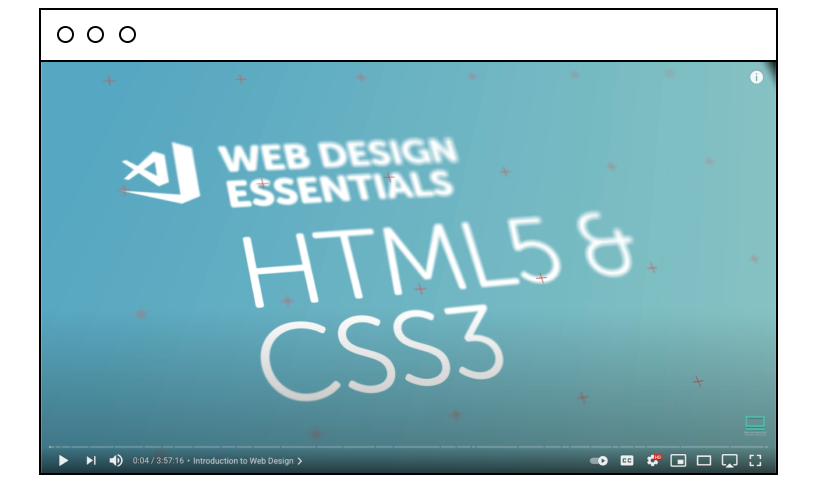
Daniel Scott, a professional designer and YouTuber, developed this free online web design course. His YouTube channel, Bring Your Own Laptop, has gathered more than 272K subscribers. The course consists of a single four-hour video educating you on creating three responsive websites from scratch using HTML5 and CSS3. The course also provides hands-on practice through a downloadable package of exercises (free of charge).
Design concepts the course teaches:
- HTML and CSS basics
- Head, body, and HTML tags
- CSS classes
- External CSS
- Web structure
- Div nesting
- Handling media elements
- CMS and dynamic content
- Navigation
- Layout and styling basics
- Responsive design
- SEO
- Website testing
If you are a newbie at codes and scared of HTML, this entertaining and insightful course is a great place to start.
Audience: BEGINNER.
Estimated time: 4 hours.
Pros:
- The course provides high-quality entertaining content and easy-to-follow instructions (according to the comments under the video).
- The course is a true shortcut to web design. It clarifies the essentials, making complex things simple and leaving no blank areas.
Cons:
- No certificate available.
- Very basic. It is a free excerpt from the designer’s paid full-fledged 16-hour web design course called Responsive Web Design Essentials – HTML5 CSS3 Bootstrap available for subscription ($12/month).
Price: FREE.
2. OpenClassrooms: Build Your First Web Pages With HTML and CSS
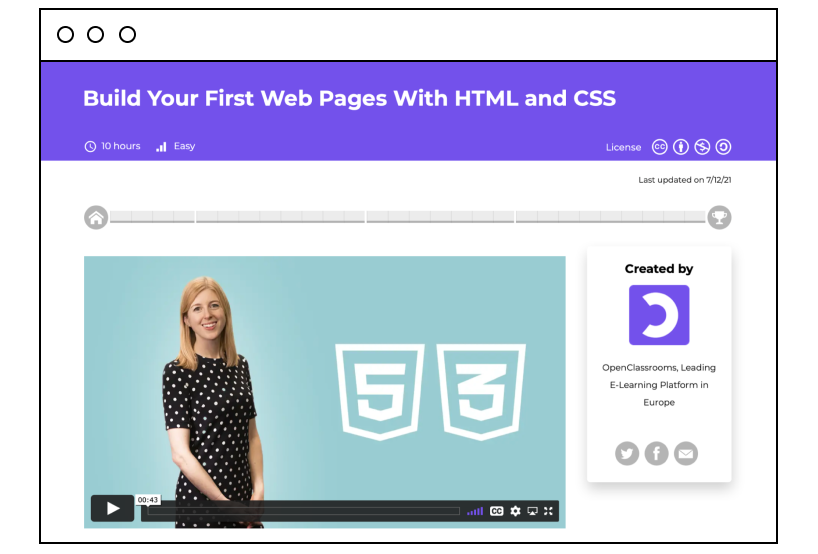
HTML5 and CSS3 are the cornerstones of the web and two basic languages every newbie to web design has to grasp. This introductory course by OpenClassrooms in the form of four modules (paths) teaches how to create web pages using HTML and spice them up using CSS. In addition, it explains how these two languages complement each other and can be used to render any website. You don’t have to have any special coding skills to join this course because it starts from the very basics.
Concepts the course teaches:
- Basics of HTML5 and CSS3 and their separate uses
- Correct syntax of HTML elements, HTML tags
- CSS styling
- Page structure and SEO
- Image and fonts optimization
- Color theory
Audience: BEGINNER.
Estimated time: 5–15 hours (depending on your own pace).
Pros:
- Quality educational content (text + short video lessons) developed by field experts.
- Quizzes and self-corrected activities for hands-on practice.
- Insightful Codepen entries showing how various codes work.
Cons:
- The course is great only if you are absolutely new to HTML and CSS. Design concepts are explained very superficially.
- A certificate and video downloading feature are available only for premium members (€20 per month/about $24 USD).
Price: FREE.
3. Coursera: Web Design for Everybody: Basics of Web Development & Coding
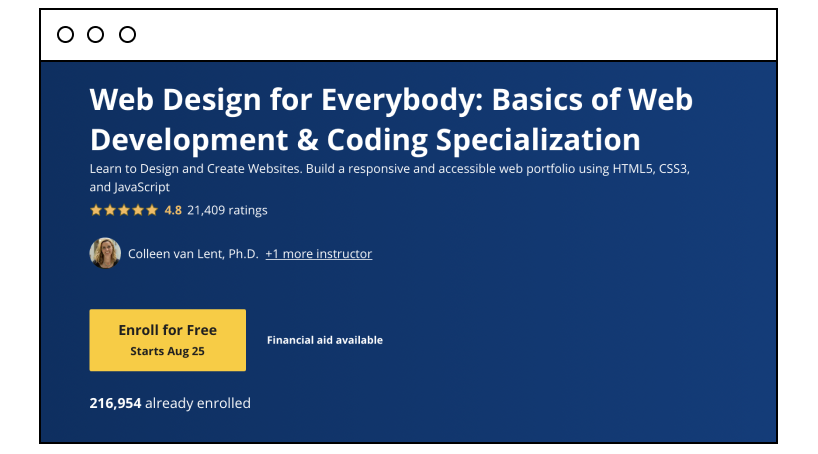
To make a portfolio website is more important for a web designer than to get a university education. However, it’s nice to know that you can have both and…for free. This web development and coding course by the University of Michigan will introduce you to HTML5, CSS3, and JavaScript basics. This knowledge will help you create your first responsive web portfolio that will work seamlessly on any device.
The topics you will learn:
- Basics of HTML, Cascading Style Sheets (CSS), and JavaScript
- Creation of interactive elements with JavaScript
- Using the Document Object Model (DOM) for modifying pages
- Bootstrap (Front-End Framework)
- Web accessibility
- Responsive design
By the way, Coursera offers more than 250 courses for web enthusiasts. If you liked this university offering, you might also be interested in the course Web Design: Strategy and Information Architecture by CalArts. It will help you pump up your Adobe Illustrator, Adobe Indesign, and Treejack skills.
Audience: BEGINNER.
Estimated time: 3 months (70 hours of learning).
Pros:
- The course provides a solid foundation of HTML5, CSS3, and JS.
- Enthusiastic community of motivated learners.
- Experiments, quizzes, and reviews for consolidating learning.
- The course is free to audit unless you need a certificate.
Cons:
- Some learners complained about quizzes and the final project having typos.
- The certificate is available only for members ($49/month).
Price: FREE to audit.
4. TreeHouse: Web Design Track: Web Design Process
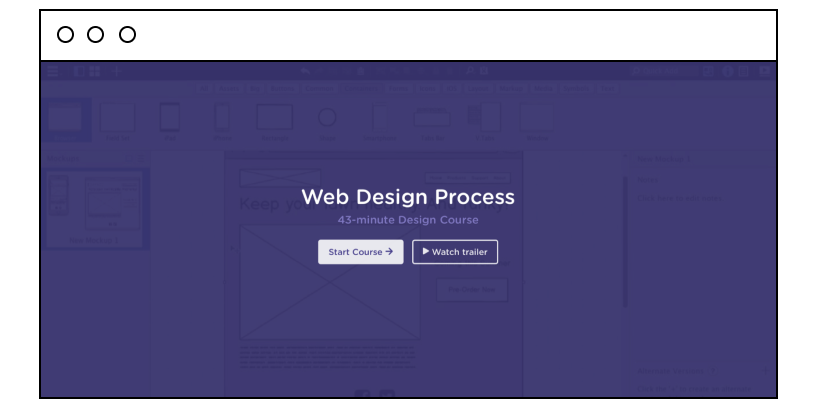
The educational platform TreeHouse developed the web design track, a series of short web design courses teaching the basic principles of web design such as code languages, color theory, branding, typography, etc. We recommend their course Web Design Process to those who want to grasp how to create great and mindful design step by step.
The course focuses on the two major stages of the design process. At the “Discovery” stage, you learn to gather information and better understand your audience. The second “Exploration” stage teaches you to transform your ideas into design concepts and prototypes with a focus on responsive design.
If you liked this course, you should also explore other courses from the web design track. There are more than 40 hours of interactive lessons and videos covering HTML, CSS, Ruby, JavaScript, Python, responsive design, layouts, UI/UX, and many other topics.
Audience: BEGINNER.
Estimated time: 43 minutes (of video).
Pros:
- Solid, in-depth, and, what is also important, up-to-date immersion into the design process. (By the way, TreeHouse cares about keeping all its design courses up-to-date with the latest web design trends.)
- The gamified, interactive learning style keeps you motivated throughout the process (you earn badges as you pass different challenges and quizzes).
- An active online community to learn from.
- Seven-day free trial (to check out the training before buying a subscription).
Cons:
- You cannot get the certificate for tracks. It is available only for the Techdegree program ($199/month).
- Video downloading feature is available only for premium plans.
- If you are a busy person prone to delaying your learning progress, the course can turn out to be quite expensive.
Price: Subscription-based, starting at $25/month.
5. LinkedIn Learning: Introduction to Web Design and Development
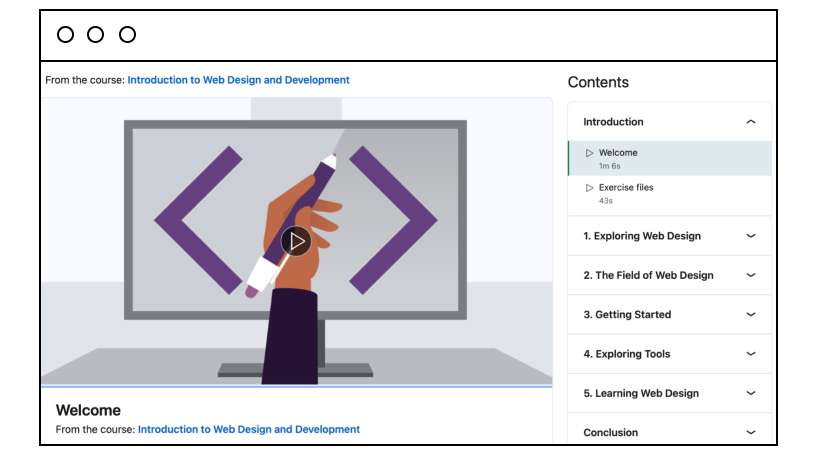
It was quite logical for LinkedIn, as the world’s largest professional network, to create its own Learning hub to feature courses from the network’s top-tier professionals. So if you value quality and look for top web design courses from respected instructors, look no further than LinkedIn.
The introductory course Introduction to Web Design and Development by James Williamson, Adobe Certified Instructor, was designed to introduce you to the best coding practices in web design. In addition to HTML and CSS basics, the course sheds light on the hot web design jobs on the market and the best tools web designers use in their everyday practice.
Audience: BEGINNER.
Estimated time: 3–4 hours.
Pros:
- The course contains downloadable exercise files that help you follow along with the instructor.
- High-quality curriculums and vetted instructors on the Learning hub.
- One-month free trial.
Cons:
- For a beginner level, it’s not the most in-depth course available on the market.
Price: Subscription-based, starting at $19.99/month.
If you like this course, you may also try Sketch Essential Training: The Basics if you want to learn how to create amazing user experiences with Sketch.
The Best Online Courses for Qualified Web Designers
1. Designlab: UX Academy: Learn UX UI Design
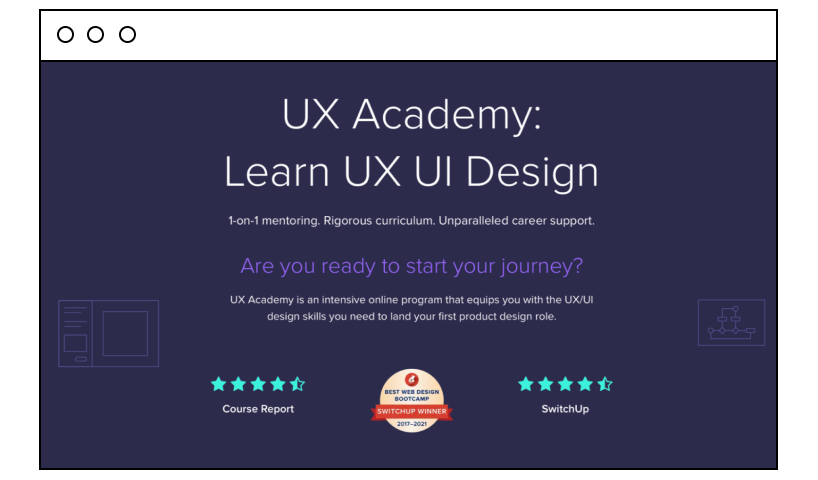
If you were looking for the most comprehensive UX/UI design course to jumpstart your design career, that’s it. This course boasts a very intensive curriculum focusing on UX/UI design fundamentals and career placement. It will take approximately eight months to digest, provided that you devote at least 20 hours per week to study.
Audience: EXPERIENCED.
Estimated time: 8 months on average.
Pros:
- One-on-one mentoring with top-tier UX/UI designers with at least three to five years’ experience. Cooperation includes weekly calls, answering questions in real time, written feedback on design projects, and career advice.
- Possibility to upload your design projects to the Designlab platform and get feedback from your mentor and fellow students.
- 12 group crits (discussions) to present your design work, which is a good experience before serious job interviews.
- Unlimited access to the community of professional designers on Slack.
- Four substantial portfolio projects and more than 100 design exercises.
- Career coach to instruct you in landing your dream job.
Cons:
- The course is very time-consuming. Be ready for more than 480 hours of UX design projects and coursework.
- Expensive.
Price: $6249 if paid upfront. Payment plans are available.
2. Udacity: Frontend Development Nanodegree
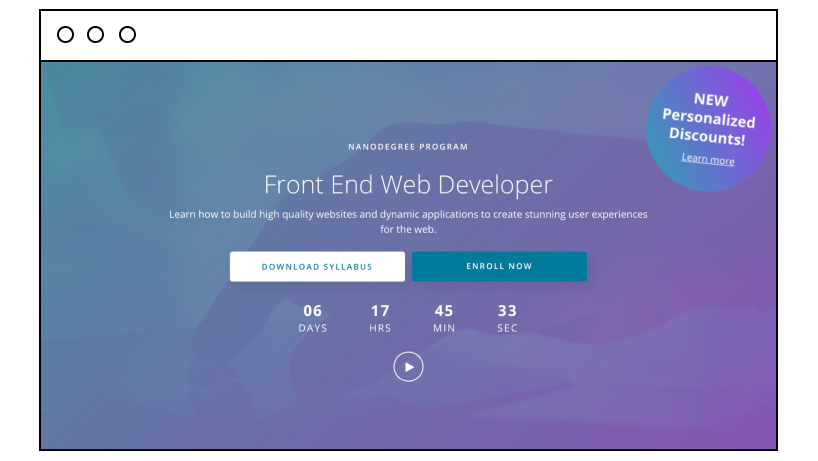
Udacity is a platform for life-long learners specializing in career-focused, vocational courses for professionals called “Nanodegrees.” Like all other Udacity courses, Frontend Development Nanodegree is project-based. It means that it walks you through creating a project and then helps you create your own project using the experience you gained. You will deepen your knowledge of HTML, CSS, and JS during the course and learn how to build responsive and dynamic websites with fantastic user experiences.
The curriculum also includes:
- Creating dynamic, optimized landing pages with marketing content.
- Cutting-edge web APIs.
- Automation of repetitive tasks using Webpack and other tools.
Audience: EXPERIENCED. Prerequisites: basic knowledge of HTML, CSS, and JavaScript.
Estimated time: 4 months, at 5–10 hours/week.
Pros:
- Deep, university-level curriculum heavily weighted toward web development.
- One-on-one mentorship with first-class tech professionals.
- Building your own project and getting authoritative feedback and reviews.
- Assistance from a career coach at the end of the course.
- Certificates available.
- Seven-day free trial.
Cons:
- The course requires a substantial time commitment.
- The curriculum is targeted at experienced specialists rather than beginners.
- Expensive.
Price: $399/month or $1356 one-time fee for the entire course (four-month access).
If you liked this course, you should also try Full Stack Web Developer on Udacity (same price, same duration).
3. Pluralsight: The Art of A/B Testing for Web Design
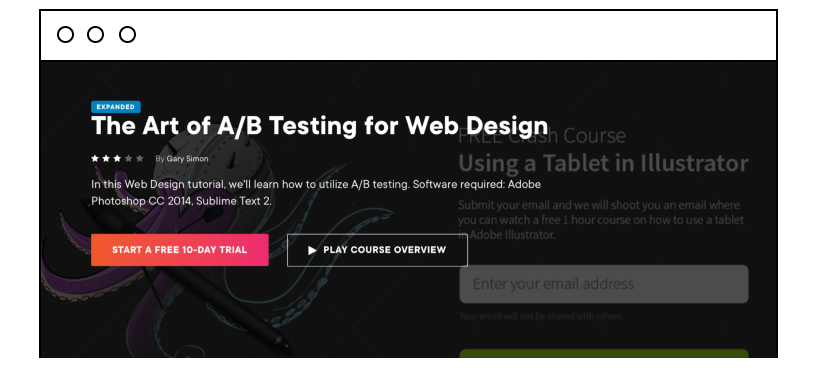
The tech learning platform Pluralsight conveniently groups courses into “paths” for a deeper immersion into specific areas of web design (for example, UX design, graphic design, etc.). The web design course The Art of A/B Testing for Web Design by Gary Simon is perfect for those looking to polish their A/B testing skills. You will learn how to design a mockup in Photoshop and use split testing to maximize your page usability and increase user engagement. During this course, you will build a responsive landing page and integrate an A/B testing script to analyze the results.
Audience: EXPERIENCED. The course requires knowledge of Adobe Photoshop CC 2014 and Sublime Text 2.
Estimated time: 2–3 hours.
Pros:
- In-depth understanding of A/B testing.
- Pluralsight’s own testing service, helping to test your projects and see how your skills advance.
- 10-day free trial.
- A relatively cheap and quick course to close your skill gaps.
Cons:
- Interactive lessons, certification exams are available only for more pricey Pluralsight plans.
Price: subscription-based, starting at $29 per month.
4. Udemy: Professional WordPress Theme & Plugin Development
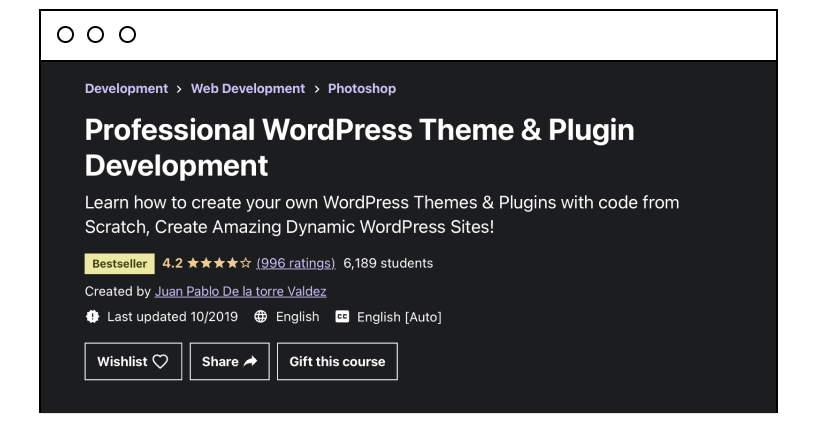
WordPress is the world’s most popular CMS with tons of themes to use in your website. However, if you want to build an impressive portfolio, you should learn to create your own custom themes on WordPress. This course will give you an insight into what’s going on under the hood of WordPress drag-and-drop editor and teach you how to build beautiful dynamic web pages from scratch. During the course, you will create four different WordPress themes and learn how to transform PSD files into templates, create mobile-first themes, and work with Options Pages, Custom Post Types, Custom Fields, and Widgets API.
Audience: EXPERIENCED (basic HTML, CSS, PHP, and JavaScript knowledge is required).
Estimated time: 35 hours of on-demand video.
Pros:
- Detailed, unhurried explanation and quality step-by-step videos.
- The outcome is four complete projects, which will be a perfect addition to your web design portfolio.
- 138 downloadable resources (images, content, and other materials).
- Lifetime access (including from mobile and TV) to the course and its materials.
- Learning at your own pace.
- Certificate of completion.
Cons:
- The price can change.
- No use for beginners.
Price: $10.99.
5. Interaction Design Foundation: How to Design for Augmented and Virtual Reality
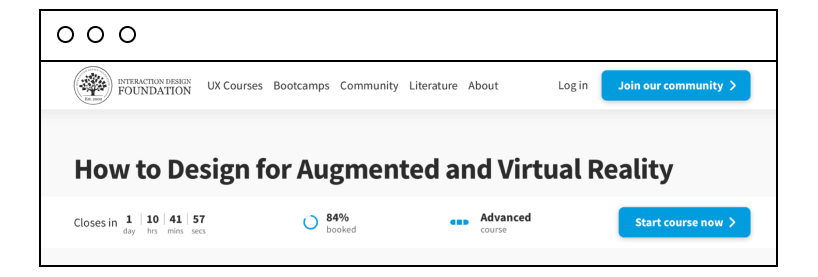
Such giants as Google, Apple, and Microsoft are pushing augmented reality and virtual reality, which continue to gain popularity. So, it’s a crime for talented UX designers to stay aside. This course will teach you how to create a fantastic user experience, but now with 3D content. You will learn three keys of 3D design (storytelling, imagineering, and improvisation) and get the hang of creating 3D personas and leveraging brain signals in 3D interfaces.
Audience: EXPERIENCED.
Estimated time: 3–5 hours for each of the eight lessons.
Pros:
- Eight lessons designed by industry experts.
- The course starts from the basic material but quickly builds toward complexity.
- Industry-recognized course certificate.
- Self-paced course with no deadlines.
- Expert revision of tests.
- Friendly community of eager learners.
Cons:
- Access to the course materials is limited to the duration of your membership.
- Personal coach is available only for premium members ($200/month).
Price: Membership-based, starting from $16/month, paid yearly.
The Great Web Design Courses Are Never Enough
Top designers never stop learning. Online web design courses are a fantastic way to keep yourself in perfect expert shape as new trends and technologies come and go. The more design areas you try and skill sets you get, the more in demand, motivated, and confident you feel on the market.
The best online web design course is the one that lets you step outside your comfort zone and explore new ways of creating stellar user experiences. We covered only a few courses provided by a few learning platforms. But don’t stop there. Other learning hubs (such as Skillshare, Skillcrush, freeCodeCamp, General Assembly, Envato Tuts+, FutureLearn, BrainStation, etc.) are also great places to sharpen your designer mind.

